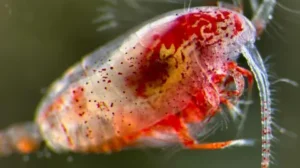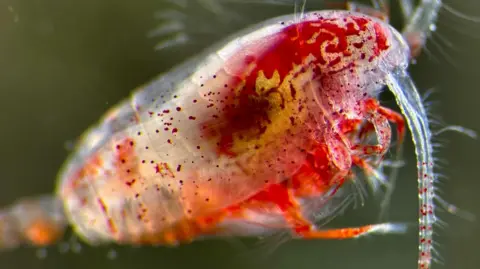**Tiny Heroes of Climate Change: How Zooplankton Combat Global Warming**
In a notable revelation about the impact of microfauna on climate change, scientists have discovered that an often-overlooked group of tiny marine animals, known as zooplankton, plays a crucial role in fighting global warming. A recent study illustrates how these minuscule creatures engage in a remarkable migration process that significantly contributes to carbon sequestration in the ocean. The findings suggest these “unsung heroes,” although commonly regarded as mere fish food in aquariums, can help mitigate climate change by locking away a substantial quantity of carbon emissions.
Zooplankton consume large amounts of food in spring, resulting in substantial weight gain. After this gorging phase, they dive deep into the Southern Ocean near Antarctica, descending several hundred meters where they utilize their energy reserves. This downward journey effectively encrypts carbon dioxide from the atmosphere into the ocean’s depths, promoting the condition that current atmospheric levels could be nearly double their present state without this biological mechanism. Researchers equate the amount of carbon sequestered by zooplankton to the annual emissions of around 55 million cars.
**Importance of Zooplankton in Ecosystems**
The significance of zooplankton was elucidated by Dr. Guang Yang from the Chinese Academy of Sciences, who led the study. He highlighted that previous expectations regarding the extent of carbon storage by the Southern Ocean were dramatically understated. In collaboration with Dr. Jennifer Freer from the British Antarctic Survey, it became evident that these animals are noteworthy contributors to carbon management, warranting increased attention compared to their more charismatic counterparts such as whales and penguins.
Despite their ecological importance, zooplankton frequently go unnoticed. Dr. Freer emphasizes their unique lifestyle and the extraordinary circumstances surrounding their migrations. The research spotlighted certain species, such as copepods, and illustrated their complex life patterns, for instance, resting at depths between 500 meters to 2 kilometers and living in a primarily quiescent state.
**Research Findings and Methodology**
The current studies required extensive research into the zooplankton’s migration rhythms in the Antarctic waters over numerous years, including voyages on the polar research vessel Sir David Attenborough. Comprehensive methods enabled researchers to surveil zooplankton populations and measure their contributions to carbon sequestration. The study discovered that zooplankton’s annual migrations channel approximately 65 million tons of carbon to depths of at least 500 meters each year, with copepods being the primary contributors, followed by krill and salps.
Notably, this seasonal vertical migration pump occurs daily, pairing with the biological cycle during which the creatures excrete carbon-rich waste, further deepening the dependency of marine ecosystems on zooplankton for effective climate regulation. This process can take decades to retrieve the carbon released, hence ensuring prolonged atmospheric stability.
**Challenges Facing Zooplankton**
However, this vital ecosystem service is imperiled by climate change and other anthropogenic influences. Rising ocean temperatures and commercial overharvesting of species such as krill pose significant threats to zooplankton populations. In 2020, nearly half a million tons of krill were removed from the Southern Ocean per international regulations, raising alarms among conservationists regarding the sustainability of these marine species.
Dr. Angus Atkinson underlined the urgency of integrating such biological processes into climate models, especially regarding predictions of future atmospheric CO₂ levels. Continued research into these unsung heroes remains critical, not only to illuminate their essential role in carbon cycling but also to address potential disruptions to their populations due to environmental changes.
As scientists continue to explore the depths of these marine ecosystems, the findings bear profound implications for our understanding of climate regulation and the interconnectedness inherent within oceanic life. Preserving the thriving populations of zooplankton—along with the habitats they depend on—could serve as a frontline defense against ongoing global warming trends, underscoring the necessity of fostering marine biodiversity for a sustainable future. The full study was published in the journal Limnology and Oceanography, reaffirming the call to pay heed to the small yet impactful agents of ecological balance.











